The Rukka Armaxis is the Finnish company’s latest ultra-spec, Super DeLuxe, Armageddon-inspired deluge-avoidance protection system. It’s also a three-season motorcycle jacket! The Armaxis is loaded with the current state-of-the-art fabrics and technology available for motorcycle jackets. For example, it includes the Gore-Tex Pro Shell With Armacor (Report), which is guaranteed waterproof. It does this at the outer shell layer without requiring a secondary waterproof liner.
Even the cuff liners are Gore-Tex and the main entry zipper is a YKK Vislon Aquaseal type that has been tested to the ISO 12402-7:2007 standard for immersion. Special next-generation Rukka D3O CE Level 1 protectors are included and this time they’re thick, perforated and huge. And a Level 2 Rukka D3O back protector is included with the Armaxis jacket.
The thermal liner is a Windstopper type with a very soft and comfy interior and it’s also designed to be worn alone as streetwear. The Armaxis comes with a removable Gore-Tex neck gaiter, which protects the neck and face in very cold weather. The tall collar with neoprene upper and attached inner sleeve cuffs also work well.
And they are the clue that tells you the Armaxis is designed for fall, winter and spring riding; the Rukka Airman (review) or Rukka Airider (review) would be better choices for hot weather. But for cool, cold and/or wet weather, the Rukka Armaxis has to be the most protective short length motorcycle jacket you can buy.
Put it on your holiday wish list and keep your fingers crossed that Santa will deliver…
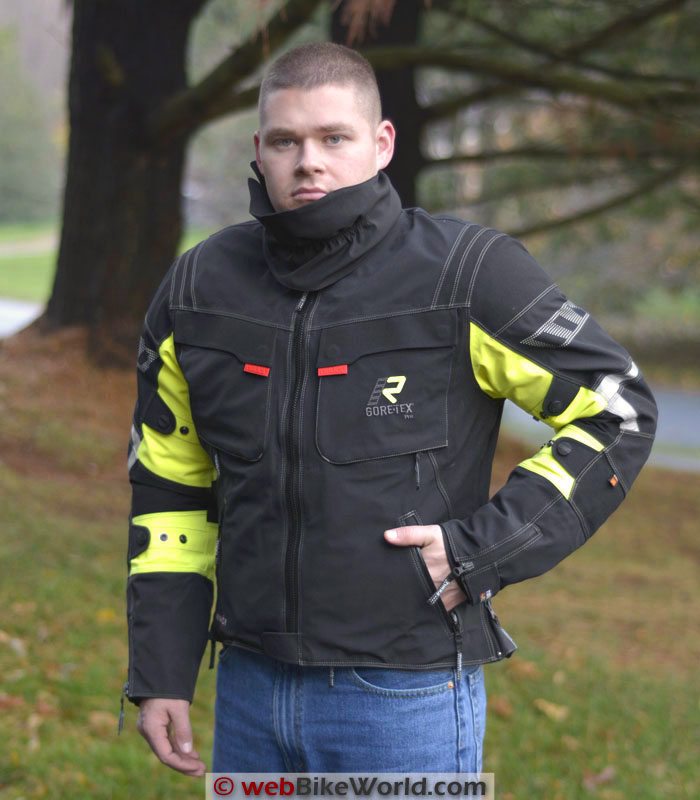
Background
Rukka has been on a roll over the last couple of years.
Despite the infarction-inducing list prices of the Finnish company’s gear, serious motorcyclists have been scarfing ’em up as fast as Rukka can pump ’em out and Rukka has been releasing new designs to meet the demand.
The Armaxis is the latest version of Rukka’s “all-singing-and-dancing” top-of-the-heap premier three-season jacket. It’s similar to the Rukka Armas jacket (review) and the Rukka Armaxion jacket (review) but with improvements.
I’d like to believe that Rukka has incorporated the webBikeWorld suggestions and criticisms in previous Rukka reviews in designing the Armaxis.
That’s because it’s the most comfortable Rukka jacket yet and just about all of the criticisms we had with previous Rukka jackets have been incorporated.
Which also brings us once more to our high-end gear review note that “the higher the list price, the more critical the review”. Our job is to be critical and to find the nits so that you can make a more informed decision.
And when we’re talking clothing in the stratospheric $1,000+ range, that critical eye becomes a laser focus.
In other words, issues that would easily get a pass on a low-end, low-cost product quickly become glaring faults when we’re talking big, big bucks.
One other note before we get going: remember that the Armaxis is shorter length jacket, similar to the aforementioned Rukka Armas.
To get the most out of its features, I’d suggest buying a matching set of Rukka pants, like theRukka Armas pants (review) or the Rukka Armaxion pants.
Not that the Armaxis doesn’t look good with a pair of jeans, but it just seems silly to spend all that money to get the weather protection offered by the Armaxis on the upper half of the body only. Don’t forget that lower half…
The Rukka Armaxis Jacket Shell
The Armaxis jacket is new for 2014 and its spec sheet is right up there with the Armas.
But the Armaxis has some newly incorporated features that make it more every-day usable, while not reducing any of its Rukka-ness in terms of its protective properties.
The Armaxis jacket is made from the top-of-the-line Gore-Tex Pro Shell With Armacor (Report), which is waterproof and breathable at the outer shell boundary, so you won’t have to mess with a separate waterproof liner.
As we’ve stated before, this is the “Holy Grail” of motorcycle jacket textiles that many motorcyclists (somewhat unreasonably) demand (but don’t want to pay for).
Personally, I think there can be some advantages to a separate waterproof liner, but like many others, I’d just as soon have that waterproof-ness built in to the shell (as long as it also breathes) so I don’t have to worry about bringing another layer.
The outer shell of the Armaxis is built with an interesting layered fabric section concept, as you can see in the photos of the shoulders and arms.
While this may increase the number of stitch rows, it seems to have added a certain amount of movement freedom to this jacket compared to other Rukka jackets.
The jacket is also fairly hefty; the size 52 Armaxis weighs 2.6 kg (5-3/4 lbs.) with its full complement of protectors (including the back protector) but without the thermal liner. The total with the thermal liner is 3.2 kg (7.0 lbs.).
You won’t find any Superfabric on the Armaxis and I’d have to argue once more that it’s a good thing in this case and I don’t think the absence compromises the jacket’s protective abilities.
Instead, the “Armacor” part of the Gore-Tex Pro Shell With Armacor gives the jacket its abrasion resistance. Superfabric — if not done right — can add a stiff feeling to a jacket and the Armaxis feels more comfortable without it.
Rukka D3O Protection
The other new addition is the latest generation of the Rukka-designed D3O protectors in the shoulders, elbows and — yes! — the standard back protector.
It’s the latest generation of this partnered protection system that has been developed by Rukka with D3O and although I’ve been critical of D3O protectors in the past, I think they finally nailed it with this generation.
The latest version of the Rukka D3O protectors feel softer than before and if size means anything, they are huge — much larger than any of the shoulder and elbow protectors we’ve seen before.
Yet, even with their size, they don’t get in the way and they’re comfortable. In fact, I never realized they were so massive until I pulled them out to take a look (photos in the slide show below).
Previous iterations of the D3O protectors in Rukka products had a stiff feel that made me wonder how they could actually absorb initial impact energy as efficiently as other brands.
But the new stuff addresses all my concerns and both the shoulder and elbow protectors are CE Level 1 certified, while the included back protector is a Level 2 device.
All of this means you get not only the protective outer shell but a very nice selection of internal protection and the combination of both is one of the reasons this jacket costs more than others.
YKK Vislon Zipper With Aquaseal
Another signature feature of the Armaxis jacket is the Vislon YKK Aquaseal zipper for the main entry.
It meets the ISO 12402-7:2007 standard for personal flotation devices, believe it or not.
The 10 mm wide YKK Aquaseal zipper works just like a regular (big) YKK Vislon zipper but it seals out water and the Vislon has a bonus benefit of being much more resistant to UV light.
Just for kicks, we pooled water on the zipper and it just sat there without leaking a drop.
Vislon is often used for closures in the marine environment due to its UV resistance and the Vislon Aquaseal zipper is used for things like “surface abandonment suits”.
It’s also claimed to pass exposure tests for immersion in diesel, detergent, salt spray test and accelerated weathering.
The Aquaseal zipper replaces the Gore Lockout closure system (report) used in the Armas jacket that some owners didn’t like.
Personally, I’ve never had any problems with Lockout closures and I rather like them although it’s a moot point because the Aquaseal zipper is waterproof and it feels just like a normal zipper in its operation.
3 Season Use?
Like the Armas, Armaxion and other Rukka jackets, the Armaxis jacket has that “built like a tank” feel, whether you’re just handling it or wearing it. The shell is very substantial and with the thermal liner, it should be all you need for anything other than the hottest weather.
The Gore-Tex Pro Shell performs very nicely when riding in cool temperatures. I can feel air pressure on my chest but not a molecule of the stuff gets through the jacket and I feel perfectly comfy inside.
The effect is even more pronounced when the thermal Windstopper liner is used.
I can ride with the liner installed with just a T-shirt underneath in temperatures ranging down to 12 C (55 F) or so. Lower than that, I throw on an extra turtleneck long-sleeve shirt or performance under-layer and I feel certain that will hold me down to the lowest temperatures I’d care to ride in anyway.
Sizes, Sizing and Colors
This Armaxis is a size 52 and it fits somewhere between a standard U.S. size L and XL, so let’s call it a “large-and-a-half”. Rukka sizes tend to run about one size big anyway, perhaps to allow for layering underneath.
For example, the model shown in the photos has a 44″ chest and you can see the jacket fits him and it even has a touch of extra room (the liner is installed in the jacket in these photos).
The Armaxis is available in sizes from 46 to 60 Euro.
Rukka is imported and sold by RevZilla, a webBikeWorld affiliate retailer. The RevZilla size chart for Rukka lists a 52 jacket fitting a 40.2 inch to 41.3 inch chest with 31.5 inch sleeve length, but I think this is way off.
Anyone with a 40 or 41 inch chest will be absolutely lost inside a 52 Armaxis — as you can see by the 44″ chest and 34″ sleeve length of the model shown in our photos.
In fact, the model in the RevZilla Rukka Armaxis video has a 42″ chest and is wearing a size 50. But the size 50 in the chart shows a 38.6 to 39.8 chest size, so something isn’t right with the chart.
My feeling is that the size 52 is the equivalent of a slightly roomy U.S. size large. As another data point, I have a 43″ chest and 35″ waist and the jacket feels slightly big on me; in f;act, I would like to try a 50 just for comparison.
One thing to note is that there isn’t really a lot of stretch at the back of the shoulders and that should be taken into account for sportbikers. On a more upright bike like the 2014 Suzuki V-Strom 1000 ABS (Blog), the jacket works perfectly fine, however.
I don’t have a pair of Rukka pants handy so I’ve been wearing the Armaxis over an old pair of off-brand heavy-duty thermal lined winter pants (black Cordura-like textile). The jacket has a large hook-and-loop belt connector though that can be looped through a waist belt on a pair of pants to hold the rear of the jacket.
The Armaxis also has a full-length zipper inside at the hem in the rear that matches Rukka pants, but it does not have the typical 8″ short zipper and the long zipper doesn’t include the second zipper half that would allow you to sew it on to another brand of pants.
The belt loop works well but unfortunately, many textile motorcycle pants don’t have a belt, so if you have a favorite pair of winter pants you’d like to match with the Armaxis, a tailor may be able to attach some type of corresponding loop so you can attach the jacket.
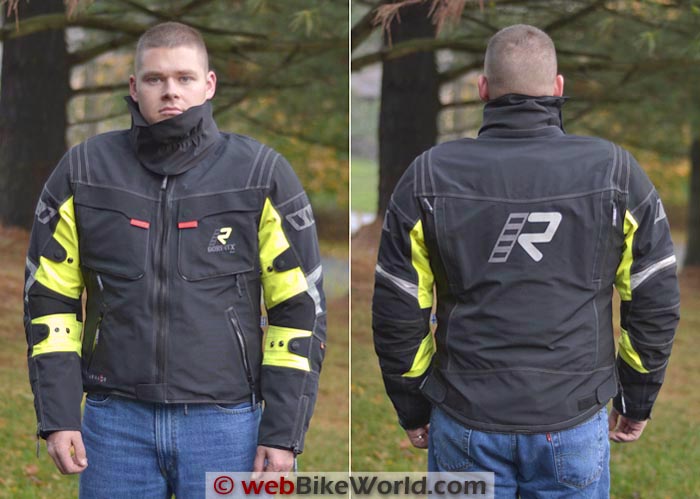
Stitching and Construction
Rukka must have read our comments in the Rukka Armaxion review about the mis-matched stitching on the shoulders of that jacket (see photos in the review).
This Armaxis jacket is very nicely built with perfectly aligned stitching and panels — very important when you’re spending 1300 semolians!
The panels and the layered shell construction — especially at the shoulders — somehow works on this jacket and gives it a purposeful type of adventure-touring look.
The Armaxis comes black or black with a touch of red or high-viz yellow on the front of the arms.
I’d still like to see Rukka use a more vibrant color palette with the patterns reversed with the yellow or red being the dominant color and black relegated to an accent role.
 Ventilation
Ventilation
This is one feature of the Armaxis that is a bit puzzling. Since the jacket has the Gore-Tex membrane shell, it breathes.
I haven’t felt sweaty wearing the Armaxis jacket, although I admit we’re in fall weather here and the highest temperature I’ve encountered so far while wearing the jacket on a ride is about 18 C (65 F).
The Armaxis has a single horizontal vent under each of the chest pockets, but these vents are hidden underneath the bottom of the pockets so they are pretty much non-functional when they’re open.
When air pushes against the pocket when you’re riding, the fabric effectively shuts the vent.
There are rear vents; at the rear of each shoulder lives a vertical 20 cm long vent. Both the front and rear vents use the water-resistant zipper type and not the waterproof Aquaseal Vislon zipper.
But since the Gore-Tex membrane is bonded to the inside of the jacket shell, even when the vents are open, no air can flow directly on to the rider anyway.
Any air that did manage to enter would pass over the outside of the membrane only; actually, this is how a Gore-Tex membrane is supposed to work — it needs some air passing over it to remove the moisture that wicked through.
But since this seems nearly impossible due to the front vent design, the vents seem redundant.
This isn’t really a complaint, but just to note that the vents might not be what you think. As I mentioned, the Gore-Tex membrane in the Armaxis works very nicely to block wind and water without rider sweat buildup anyway without help from the vents.
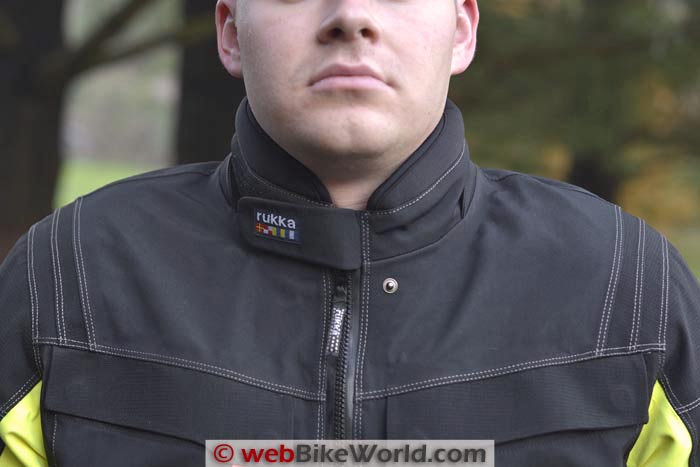
Collar and Neck Gaiter
The Armaxis has a large “stand-up” type 85 mm tall collar that includes a 35 mm band of neoprene around the top. a removable (attaches with a zipper) neck gaiter is included, as you can see in our photos.
When I first handled the jacket, I thought the collar would be way too tall and stiff.
My impression didn’t change when I first put on the jacket; I could immediately feel the collar and I remember thinking that it was too thick, too tall and too stiff to wear with a helmet.
That impression disappeared the first time out on the bike though, because the collar works really well to keep you warm.
It all makes sense once you realize that the Armaxis was designed as a three (cool) season jacket, that will keep you warm and dry. For this, the collar is a brilliant design and, in fact, I think it’s fantastic.
Granted, it may be something that may take some time to become accustomed to — and perhaps some owners never will.
But in cool-weather riding, I think it’s perfect; better, in fact, than any other collar system I’ve tried on any winter jacket.
The collar really protects my neck, right up under a full-face helmet. It’s comfortable and warm…and when your neck is warm, chances are good that the rest of you will feel warm also.
It’s just a very protective collar and the neoprene helps here also and I do think it positively helps the overall feeling that the Armaxis gives of being protected from the elements.
Now it’s possible that Rukka could have designed the collar to be removed or folded over or something and since the jacket comes with the removable wind/water resistant gaiter, you might think that is what should provide the protection from wind and rain.
But the collar has an insulation properties that the gaiter doesn’t and I’d argue that more people will be bothered by a loose gaiter up around their mouth and nose than the stand-up collar.
Bottom line: I really like the collar and I think it’s one of the best and most useful features of the Armaxis jacket.
 Sleeve Cuffs
Sleeve Cuffs
I’ve complained about Rukka sleeve cuffs in the other reviews but somehow on the Armaxis, they work. Each sleeve has a 100 mm water-resistant zipper and underneath is a permanently attached elastic cuff.
Open the zipper, fold back the shell sleeve cuff, put the gloves on with the gauntlet over the inner cuff, then close the outer zipper and you have a very protective covering from wind and water.
There is a hook-and-loop adjuster on the outer shell sleeve cuff but I haven’t found a need to make any adjustments once I get my glove gauntlet underneath.
I do think Rukka should add a dart in the construction however, because if you want to use the adjuster, there’s nowhere for the extra fabric to go when it’s folded other than become bunched under the hook-and-loop tab.
Jacket Adjustments
The Armaxis has the typical Rukka dual sleeve width adjusters on both arms; one adjuster is located at the bicep and one at the forearm. These have a total of three snaps with two for adjustment and the snap has a rubberized coating.
There’s a short waist adjuster — or rather a hem adjustment — at the rear bottom section of the jacket. Like the Armaxion, the Armaxis does not have a strap-type waist adjuster.
The jacket has a tapered cut however and if you choose the correct size, this shouldn’t be as much of an issue.
There is no dart in the fabric at the hem adjuster tab either; apparently Rukka doesn’t like using a dart but the result is that when the straps are tightened, the extra fabric has nowhere to go.
There’s also the typical Rukka vertical side opening at the hem, under the arms. This adds a size or two to the lower width, which can be a bonus, especially when seated.
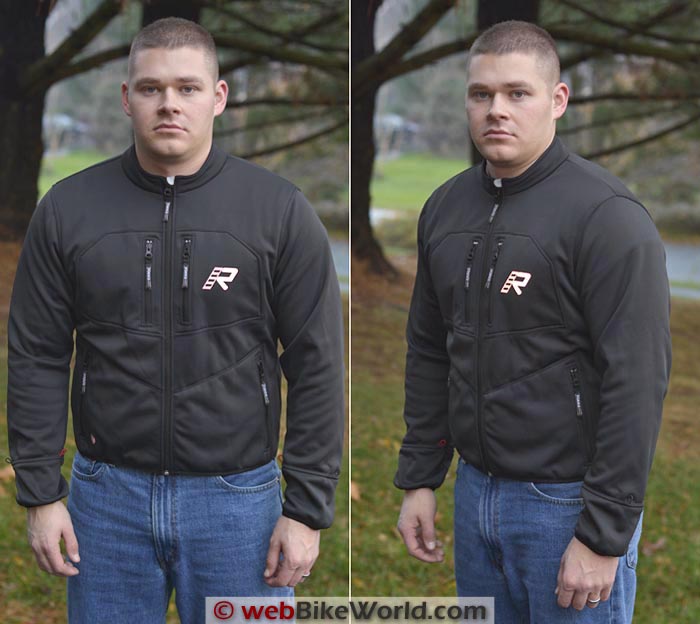
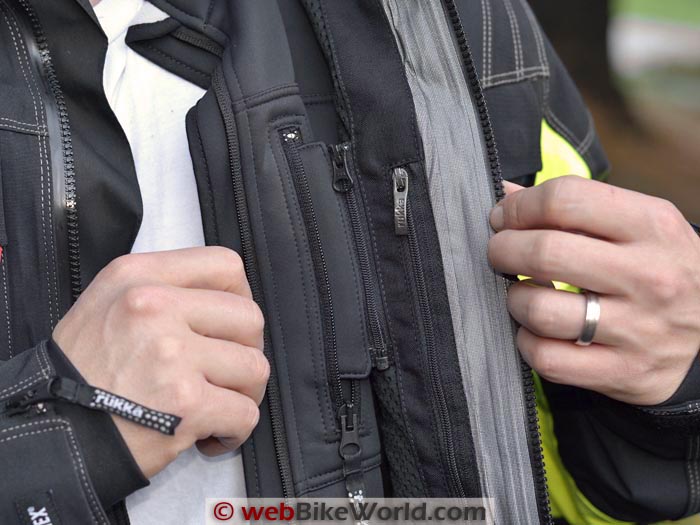
Rukka Armaxis Windstopper Thermal Liner
The thermal liner that comes with the Armaxis performs well and it’s useful. It’s a Windstopperbrand windbreaker, lined with a very soft, thick micro-fleece lining with a terry cloth cut.
The liner attaches with two snaps at the collar and it has two color-coded loops at the sleeve ends, before the cuff. The latter attach to snaps inside the shell sleeve.
There are also two vertical zippers at the chest that attach to the inside of the shell (see photo).
These zippers are hidden inside the large chest pockets in the liner and when the liner is removed, it can be worn on the street by hiding the attachment zippers in the pockets.
The liner is passable in terms of street style but the loops on the sleeves and the snaps at the neck sort of give away the fact that it isn’t a dedicated street jacket. Nevertheless, it’s wearable.
The liner is very effective at blocking wind and keeping the rider warm. I don’t really need anything other than a T-shirt underneath until the temperatures drop to around 11-12 C (~52 F).
 Pockets
Pockets
The Armaxis jacket has four external pockets, including two hand pockets on the outside with water-resistant YKK zippers. The two chest pockets aren’t waterproof and have a large flap that seals with a magnet.
There are two internal pockets, one on either placket, a nice feature also found in the Rukka Armaxion jacket. The insulating liner has two chest pockets and two hand pockets.
Bottom line? The Armaxis has plenty of storage without looking like a file cabinet.
Safety and Protection
The Armaxis jacket comes with the Rukka D3O Air protectors in the shoulders and elbows. The jacket also comes with a Rukka D3O Level 2 back protector.
The Forcefield Pro Back Insert (review) is said to fit the Armaxion jacket (available here).
The Level 1 elbow protectors and shoulder protectors are inserted in pockets inside the sleeves, while the Level 2 back protector is easily accessible via a zippered pocket opening at the lower part of the jacket in the rear.
The proprietary Rukka D3O protectors are perforated for breathability, air flow and moisture transfer.
Reflectivity
Rukka jackets have excellent reflectivity and the Armaxis is no exception. The jacket has the same type and style of laminated strips of very highly reflective material on the upper arms and mid-back that are found on the Armas and Armaxion jackets.
The brand of retro-reflective material used by Rukka is unknown, but it really “pops” when light hits it. Even when the jacket is on the hanger, any nearby light will reflect back from those strips and it is surprisingly bright.

Comparisons
Just for reference, we had put together a matrix comparing some of the features of the other high-end jackets reviewed on webBikeWorld.
By the way, Rukka has a five-year warranty on their clothing (6 years in the UK), which is another factor in the purchasing calculus.
Note also that the Richa Spirit outfit is the only other jacket to come with CE Level 2 back protector.
The Rev’it jackets do not include a back protector, which is an issue I think at those prices. The Armas and Armaxion back protectors are optional, also an issue, considering the list prices.

Conclusion
Rukka seems to be fine-tuning their products at a fairly rapid pace and that’s good. The Rukka Armaxis is one of the best yet. The jacket looks and feels protective — and it is. The Gore-Tex Pro Shell works and the street-wearable Windstopper thermal liner is a bonus.
The outer shell and the full array of the Rukka D3O protectors make this probably the most protective gear you’ll find outside of a full leather race suit. Yep, the price is stiff but there are many seasoned motorcyclists out there who won’t settle for anything less.
More wBW Rukka Motorcycle Clothing Reviews
Owner Comments and Feedback
See details on submitting comments.
From “J.D.” (November 2014): “I enjoyed your review of the Rukka Armaxis jacket. I have the Armas Jacket and Pants and can attest to their outstanding performance.
I notice that the Armaxis does not have the outlast liner, this is another part of the Armas that works very well in cold conditions.”
From “A.R.” (November 2014): “I just skimmed over the recent Rukka jacket review and I just felt compelled to comment on this.
Yes, I think it seems excellently made, yes I think it will keep me warm/dry when it comes down to it, yes I love the 5 year warranty and i wish every company would follow suit.
Will I spend 1300 bucks on something like this? H(eck) no.
I’ll ride through the winter here in DC with my normal leathers and a $100 Gore-Tex windbreaker thrown over it that will do exactly the same as this at an order of magnitude less dollars.
I guess if I were doing winter journeys to Denver and back 4-5 times a year I would probably consider it but how many riders are doing that??”
Rick’s Reply: I understand. But what you say goes for basically everything. Example: by the same logic, why buy a BMW R 1200 RT when you can buy an F 650? Why buy an Arai when you can buy an HJC?
Why buy a Mercedes-Benz when you buy a Hyundai? I can go on forever with this, but you get the point.


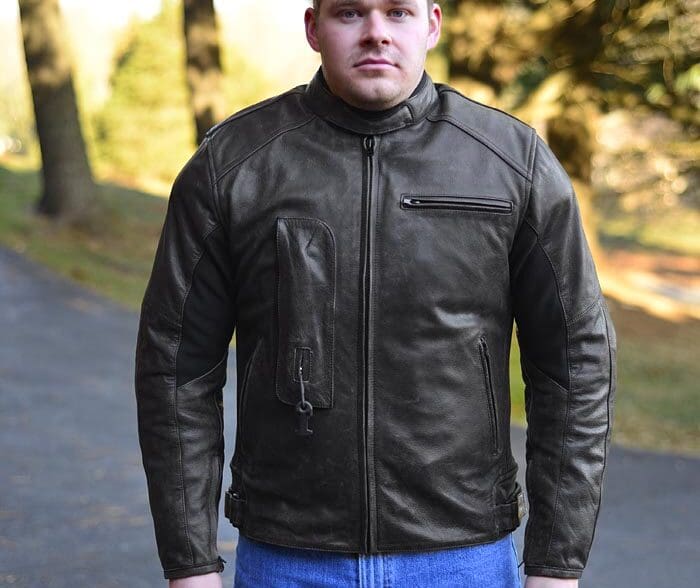



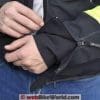


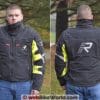

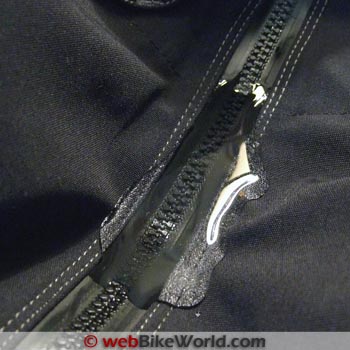
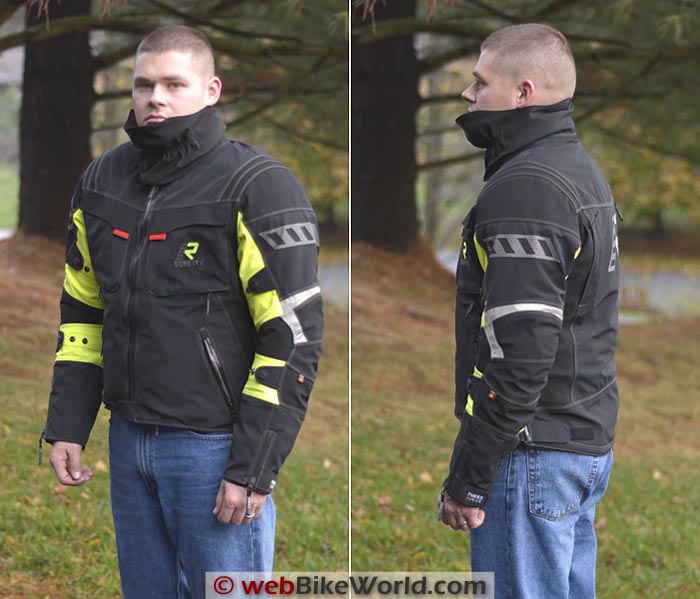 Ventilation
Ventilation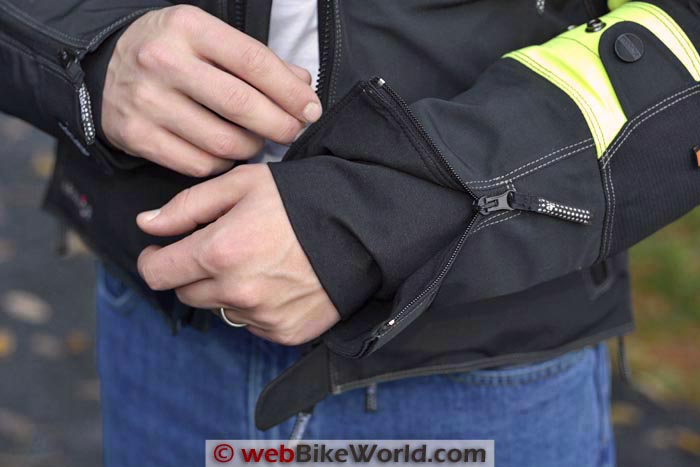 Sleeve Cuffs
Sleeve Cuffs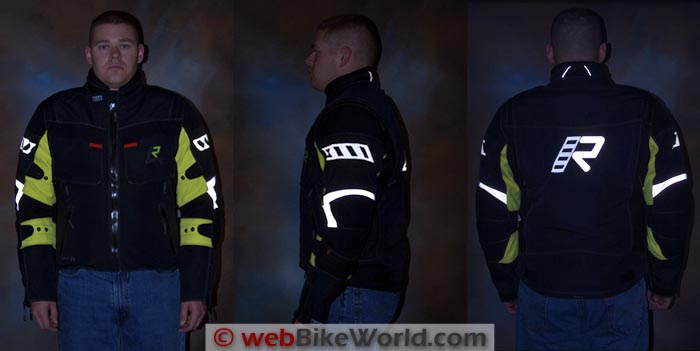 Pockets
Pockets